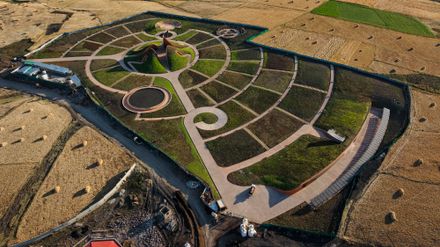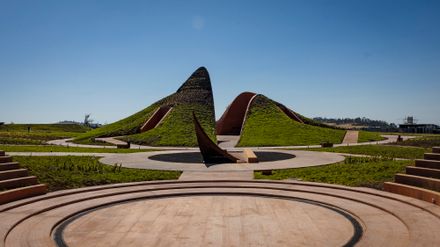The ET-302 Memorial
PROJECT TEAM
Alebel Desta Consulting Architects And Engineers
GENERAL CONSTRUCTING
Elmi Olindo Contractors
PHOTOGRAPHS
Aron Simeneh
AREA
40000 M²
YEAR
2025
LOCATION
Ethiopia
CATEGORY
Park, Memorial Center, Landscape
Text description provided by architect.
The ET-302 Memorial Park serves as a meaningful tribute to 157 individuals worldwide, telling the story of the flight's final moments.
It weaves the narrative of the crash into its design, guiding visitors along paths that lead to the crash site, burial ground, and areas for reflection, healing, and connection, all while integrating naturally into the surrounding farmland.
The design rests on three guiding principles: absence (reflecting loss), revelation (uncovering the crash story), and healing (providing solace). Central to the memorial are the crash site and the burial ground, both treated with solemn care.
A primary pathway from the southwest entrance recounts the flight's last six minutes and forty-four seconds, drawing visitors step by step toward a striking monument of four inclined, earth-red concrete structures that symbolically mark the final moments and honor the lives lost.
A secondary path from the northwest offers a more contemplative approach to the monument, while additional routes lead to the amphitheatre, gathering space, and rock garden.
The burial ground, a 28-meter-diameter sacred circle preserved in its natural state, is encircled by a matching concrete walkway and discreet inclined steel rails that create a respectful boundary. Visitors are encouraged to experience this space from the outer path, ensuring a quiet, reflective interaction with the past.
At the heart of the memorial stands the main monument, marking the exact crash location. Four sculptural forms, each representing Africa, Europe, North America, and Asia in descending height, rise from the earth with textures inspired by Ethiopia's rock-hewn architecture and the Rift Valley.
Beneath these rough surfaces, plaques in the size of a Boeing 737 MAX window list victim details by continent, while small cubicles invite private contemplation.
The monument seamlessly incorporates the filled-in crash crater into the landscape, with green roofs merging the structures into the environment. An auditory feature allows visitor voices to echo, symbolizing the monument's engagement with collective memory, while four radiating pathways extend its narrative.
The Healing Monument, located between the Asian and African structures and leading to the amphitheatre, is a corten steel sculpture evoking aerodynamic grace and resilience. Its weathered surface, punctuated by circular perforations that filter light like rays of hope, includes rivet details reminiscent of aircraft construction.
Anchored on an L-shaped foundation and surrounded by a circular walkway, it visually connects to the rest of the site while symbolizing strength and renewal. The amphitheatre, situated between the Asian and African monuments, offers six concentric, stepped seating platforms with graceful, accessible pathways.
Accommodating over 360 people, its centered circular platform is designed for speeches, performances, and memorial ceremonies, fostering community connection and remembrance.
A Rock Garden lies along the axis between the African and European monuments. Originally meant to be a flower garden, it now features large, upright stones sourced locally that create a tranquil, meditative space.
Two concentric walking paths wind through the stones, inviting visitors to slow down, reflect, and connect with the enduring nature of memory.
The facility building, seamlessly integrated into the landscape near the main entrance, includes parking for over 30 vehicles, shaded by solar panels, security points, and caretaker residences.
Two wings, one with storage, multipurpose rooms, and men's facilities, and the other with women's and accessible restrooms, caretaker quarters, and essential services, are connected by a central lobby and corten steel cover. Expanded metal mesh panels wrap the wings, enhancing privacy while reinforcing the design's natural aesthetic.
Walls leading to the monument display plaques that document the site's creation and the contributions of those involved. Finally, the overall landscape design of the memorial reflects the ripple of the crash.
With green lawns, forested areas, planted clusters, stone elements, and open paved spaces, the design echoes local agricultural textures.
Green roofs on the monument and facility buildings blend with the site, while indigenous trees and about 120,000 diverse plants provide ecological value and visual continuity, ensuring the park remains a unified and reflective tribute to loss, resilience, and hope.




























